History・Legendary(Legendary/History/War ruins)
Legendary
Sanjiro Saneku
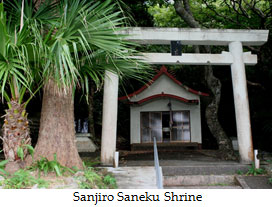 After defeat in the Hogen Disturbance of 1156, Tametomo Chinsei was banished to the penal island of Izu-Oshima (Tokyo Prefecture). Various local traditions suggest that he later island-hopped his way down the Ryukyus. One such legend relates how he stopped for a while at Saneku in Kakeroma and fathered a child with a local girl. The child was Sanjiro Saneku.
According to legend Sanjiro had fantastic strength. Sanjiro is sometimes also called “Ufuyufuganashi” in honor of his crossing the Oshima Straits from Saneku to Nishikomi with just one stroke of a giant oar.
It is said that he once challenged the hero Hachimaru Nagara of Uken to a competition of strength. Standing in Saneku and aiming for Hachimaru's hometown of Nagara, Sanjiro threw a big stone weighing almost 200 kilograms. The stone flew across the sea but didn't quite reach Nagara, landing instead at Ime, near Kuji. Not to be outdone, Hachiro returned the rock with a kick.
Sanjiro left a deep footprint in the ground when he heaved the stone, and his fingerprints were also etched into the rock itself. The “Sanjiro Saneku Shrine” was erected at this location in Saneku, and the footprint and stone can still be seen there today, together with the tomb of both Sanjiro and his mother.
Ahausyanmui of Katoku
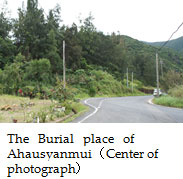 Ahausyanmui was a monstrous man-eating cow that once lived in Katoku. Ahausyanmui
had eight horns, eight tails and a huge 150 meter long nose that it used
to wrap round and crush its human prey with. Once its stomach was full,
it would remain in a motionless sleep for a week. Some say it was not a
cow but an elephant, since it had a long nose. And others say it had not
a long nose, but a long tongue.One day, Ryukyu princes journeyed to Katoku
from Syuri in Naha, planning to slay Ahausyanmui. They lived in a cave
to the northeast of the village. The cave can no longer be found, but legends
say that there is a gold tobacco pipe and a gold walking stick within.
The brothers defeated Ahausyanmui and buried it in a deep pit, around which
they planted golden stakes.
The Battle of Shodon
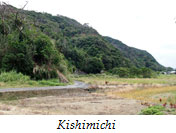 In Kakeroma’s Shodon village there once lived a beautiful priestess (noro). It was the duty of a noro to visit the Ryukyu king once in her lifetime, and so following this custom, the Shodon priestess journeyed to the Ryukyu Kingdom.
Soon after her arrival, an adviser to the king caught sight of her and fell hopelessly in love. Unable to refuse his demands, the Shodon noro agreed to be married, consenting also to remain in the Ryukyu Kingdom. She sent word to the suido (next in line to inherit the noro role) to "govern the Shodon people wisely and well" in her stead.
However when Nangumoribara, her suido, learnt that the high-ranking, powerful noro was not to return to Shodon, she began a reign of tyranny and piracy. She demanded more rice from farmers than was customary, and plundered Ryukyu-bound ships.
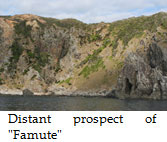 In this manner the Nangumoribara clan strengthened its power, in the process building seven warehouses in Kishimichi. But this action upset the Guryabara clan―a powerful Kishimichi family―who sent an appeal to the Ryukyu king, describing the plight of the village people and the tyrannical behavior of the Nangumoribara.
In response, the Ryukyu King sent a fleet of ships and, in concert with the Guryabara clan, tried to subdue the Nangumoribara. Attacked from both sides, the Nangumoribara army retreated, eventually withdrawing to "Famute", an impregnable natural fortress. After a futile battle, the Ryukyu forces returned, allowing Nangumoriba to both regain power and rebuild the seven warehouses.
After another appeal from Guryabara, the Ryukyu army again responded, but with a rather different strategy. The Ryukyu soldiers secretly infiltrated an April noro festival, and assassinated Nangumoriba while she was performing her priestess duties.
There exist locations in Shodon which are said to be the site of the Nangumoribara residence and the site of the Ryukyu army base.
Muchakana
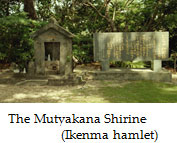 During the rule of the Satsuma domain, government officials had great power. It had become a tradition for local governors to misuse this power by taking the most beautiful girl in their village as a mistress or shimatoji.
Uratomi was said to be the most beautiful girl in the village of Ikenma on Kakeroma. The local governor heard about her and demanded that she be his shimatoji, but the proud Uratomi stubbornly refused. In retaliation, the rejected governor imposed heavy taxes on the entire district of Ikenma.
Uratomi’s parents were torn between a love for their daughter and the responsibility they felt for the suffering of the village people. Reluctantly they put their tearful daughter into a boat and sent her out to sea. The boat was carried off by the wind and the waves, arriving several days later in Onotsu village on Kikai Island. Uratomi was accepted into the village and eventually married a village man. They were blessed with a child, and lived in great happiness together.
But misfortune continued to shadow the poor Uratomi. Uratomi's daughter, Muchakana, grew up to be even more beautiful than her mother. All the men in the village were infatuated by Muchakana, and tragically this made her the envy of all the young women. One day, a band of particularly jealous women lured the unsuspecting Muchakana to the seashore and pushed her off the rocks and into a strong offshore current. Unable to save herself, the fleeting life of Muchakana was brought to a close. Upon hearing of the death of her sixteen year old daughter, the grief-stricken Uratomi threw herself into the ocean and drowned herself also.
Kantsume
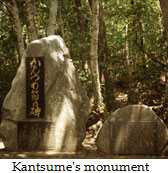 There is a sad legend that concerns Uken’s Nagara and Setouchi’s Kuji.
During the rule of the Satsuma domain, a wealty farmer was in Nagara. There was a beautiful girl named Kantsume who was a Yanchu (who had sold herself instead of debt) in the farmer’s house. Kantsume was about 18 or19. She was loved by her fellow Yanchu and the master of the house alike.
One day, a young man named Iwataro who was working as a clerk in the government office of Kuji, visited the wealthy farmer's house in Nagara. The owner had Kantsume meet Iwataro in order to entertain him. The two gradually began having feeling for each other as the night deepened. They spent the night together and Kantsume forgot about rank as a Yanchu.
The two of them loved each other, and would often secretly go on datesin the mountain between two villages of Kuji and Nagara. But their relationship came out to the master soon after. The master was furious because he had been particularly kind to Kantsume. When Kantsume came back one night wet from the night’s dew, her master pulled her down and struck her many times with chopsticks set on fire.
Kantsume, whose appearance became horrible, ran alone after work to her and Iwataro’s secret meening place. Iwataro knew nothing about what had happened, so he welcomed to her, and spent a pleasant night as usual. In the morning, Kantsume disappeared while singing, “Night falls in our world, and day breaks in your world. We would meet again when the time comes." Iwataro returned to sanity and saw the remains of Kantsume. Her spirit brought many curses to master's home. He broke down and disappeared.
Life as a Yanchu was full of hard labor and jealousy and violence from their masters. In Kantsume’s story, she had to choose death and repress her anger.
Today, on the top of the mountain between Nagara and Kuji is Kantsume's monument, built by the aged club.
History
The Mabunsyu Family Tombs
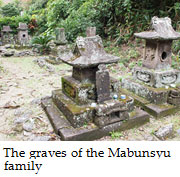 Mabunsyu was said to be second in command of the Ryukyu army that was sent to overthrow Nangumori of Shodon . In later years he lived on the "Gusuko" heights in Doren (Kakeroma). The graves of the Mabunsyu family are located near the Doren coast, and are the oldest graves with inscribed dates to be found in Setouchi (dates corresponding to the years 1693 and 1704 are engraved). Some say that the 1693 tomb is that of Mabunsyu himself, but others claim that his tomb was located at the foot of Hasama, a nearby hill, and that it has long since disintegrated.
On top of Hasama, there is a large jar called "Torahando" and an inscription-less gorinto grave (a gorinto is a small Buddhist five-tiered stupa). How this tomb came to be here and its relationship to the Mabunsyu tombs is unknown, but all these graves are managed by the same person today.
Apparently this area was also once used as a graveyard by the people of
Ankyaba, the neighbouring village. The name "Ufudacho" has been
given to the whole graveyard area.。
Kōtoku Shiba of Shinokawa
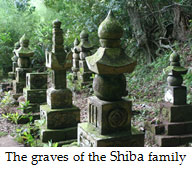 According to "Dai-Amami-shi", (a history of Amami, written in Shomu Nobori), Yoshimoto was the grandson of the founding King of the Ryukyu Kingdom. After retirement he lived in Azebu on Okinoerabu Island, where he ruled as an aji (local ruler). His second son Tsuguyoshi was made the governor of Amami, settling in Shinokawa. Tsuguyoshi can be said to be the founding father of the Shiba family. Kōtoku Shiba (born 1714) was the 22nd descendant of Tsuguyoshi.
The shogunal government of Japan protected itself by financially weakening threatening regional powers, and the Satsuma Domain had for this reason been ordered in 1754 to carry out public works on the Kisogawa River, north of Nagoya. In 1758, Kōtoku Shiba sent off 3 tons of sugar to help lessen the Satsuma Domain's financial difficulties, and four years later he gave an additional 18 tons. From 1777 to 1780 he contributed a total of 42 tons in his name and an additional 21 tons in the name of his son. When Shiba retired to Koshi at the age of 65 he gifted a further 36 tons of sugar.
In recognition of his support for the Satsuma regime, Shiba was awarded the status of gōshikaku (rural samurai). He was also allowed to formally take on a surname (surnames were not in common use at this time). When Shiba learned that the Satsuma mansion in Edo (now Tokyo) had burnt down he sent off 60 tons of sugar. From that time until his death in 1795 he sent 55.8 tons, and his son (honoring a promise that his father had made) gifted 3.6 tons.
It would seem that Shiba's life was one given over to the donation of sugar, but Shiba also happened to be the first person in Amami to make woolen fabric and the first to cast a gun. In 1772 he went to Kagoshima on official business, and before returning to the islands he learned how to weave wool. Shiba made a new weaving machine and gifted some of the resulting fabric to the Satsuma Domain. Shiba also spent six years in the making of two guns.
Shiba died in 1795 at the age of 82. The overgrown site where Shiba's house once stood lies behind Shinokawa Elementary School, and the Shiba gravestones can be found in a corner of the village.
The Take family of Sedake
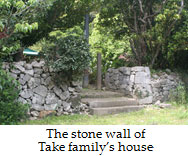 The Take family was a wealthy family on Kakeroma. The beginning of their good fortune occurred in 1793 when Eiki Asa became a government official in the Nishi-magiri administrative region. Members of each succeeding generation of the family were also appointed to various government positions. In 1826, a member of the family was awarded the status of gōshikaku (rural samurai). Surrounded by stone walls and hedges, the Take mansion can still be seen in Sedake village. It was made in the shoin style (a major style of architecture that was particularly favoured by the wealthy at this time).
The Take family graves are set apart from those of the other villagers, and the dates engraved correspond to the years 1828, 1845 and 1855.
The Take mansion is particularly important because it houses a varied collection of old documents. Titles range from "Selected Writings of Confucius" and "A Guide to Zazen Meditation", through to "Sugar Ledger" and "Land Survey of Sedake Village". With few written records, much of what we know about Setouchi's history has had to come through hearsay. The Take family library thus represents a veritable treasure trove, providing a rare insight into the history of Kakeroma and Setouchi.
The Hayashi family and the Seki family of Shodon.
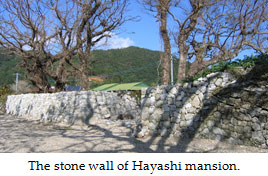 Towards the end of the feudal era, many peasant farmers had great difficulties in paying their annual tribute to the Satsuma Domain, and so they borrowed off richer farmers. This often led to higher and higher levels of debt, until finally the farmer would have to sell himself to the rich farmer as a yanchu (serf or slave).
The Hayashi family of Shodon on Kakeroma was famed for the number of yanchu it had. There is an Amami ballad that sings about the men who owned many yanchu, and according to this folksong, Maeori Hayashi of Shodon had the most of all.
After Maeori Hayashi gained the official post of chikuboku-yokome (lit. "forest and bamboo grove inspector") in 1814, he went on to serve as yohito (the highest-ranking position an islander was allowed to hold) in three different regions: Denchi, Higyahō, and Sumiyō.
In 1828 typhoons caused widespread crop failure in the administrative region of Higashimagiri, and the number of peasant farmers selling themselves as yanchu sharply increased. To ease their hardship, Hayashi distributed nearly 25000 litres of hulled rice. Rewarding his generosity, the Satsuma Domain sent Hayashi ten rolls of linen.
The Seki family was also famed for being wealthy, and they lived in the Sato sector of Shodon. In place of the yanchu he had taken on, Fukuetsu Seki contributed about 18000 litres of hulled rice and 18 tons of sugar to the Satsuma Domain.
Living in the same village with similar wealth, it was easy to think of the Hayashi family and the Seki family as being rivals, and indeed when Maeori Hayashi was fired for negligence, Fukuetsu Seki was chosen to succeed him. But although the Seki family may have one-upped the Hayashi family at the workplace, the Hayashi family remained champion in terms of wealth.
With more than 300 yanchu, a landscaped garden, and a drawing room stocked with books, swords, guns and other valuables, the Hayashi family house was of such splendour that even a visiting Satsuma domain official is said to have been amazed. Of the Hayashi mansion, apparently built in the same manner as Ryukyu castles, all that remains today is the surrounding stone wall.
Tōsumi Kiyoshi
Tōsumi Kiyoshi was born in 1747 in Seisui. Although from the Shiba family of Shinokawa, he was adopted by his maternal grandfather as the heir of the Kiyoshi family in Seisui. It is said that while still a young man, his name became widely known throughout Satsuma on account of his scholarship, his understanding of military tactics, and his proficiency in martial arts and witchcraft.
A larger-than-life figure, Kiyoshi apparently built a small steamer when he was 60 years old, and then set off on a search of uninhabited islands. Accompanied by the exile Inobe Tanaka as his adviser, their ship was blown across to Okinawa by a typhoon. However they managed to explore the Daitou Islands first (these islands became Japanese territory in 1885, and settlers arrived soon after).
Later, when Amami was hit by a serious famine, he took rice from Satsuma Domain warehouses and gave it to the starving islanders. Although his actions saved the lives of many people, the Satsuma Domain viewed them as rebellious and dismissed him from his post.
Kiyoshi died in obscurity in Sumiyou in October 1816, aged 71 years.
A Brief History of Isu Beach
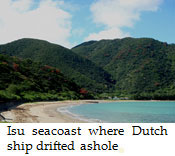 Isu village is on the coast southeast from Agina. Isu bay has calm waters and very little coral, and at low tide on March 3 (in lunar calendar) you can walk right into the bay. Isu is just a small village with few visitors in the motorized society of today, but as part of the Satsuma Domain, when trading by ship flourished, it was an important port that docked many ships. In those days Nishikomi, Keten, Kuji, Chinoura, Fukaura, Ikomo, Yui, Koniya, Shodon and Shokazu also had important ports.
According to the records of the Oshima magistrate, in June 1771 an incident
involving a Dutch ship occurred in Isu. The ship had drifted aground on
the Isu beach, and sailors were felling the trees in Kamiyama, a sacred
place, and had erected two tents on the nearby beach Nakatabaru. The village
people were shocked at the violation of Kamiyama, but neither word nor
gesture communicated their concerns to the Dutch. In response, the sailors
brought out their guns and fired warning shots, which caused the villagers
to flee in disarray. As soon as they heard the news, the local authorities
assembled a force of officials and samurai and confronted the Dutch with
ishibiya (a primitive type of cannon), but they quickly realized that they
had no chance of winning in opposition to modern guns. The local people,
who lived in fear of the "absolute power" of the Satsuma Domain,
were struck by the feeble impression the Satsuma samurai made. Fortunately
a large fight did not occur, and the Dutch finished their provisioning
and departed from Isu on July 1.
Bunien's Ruin
Doren on Kakeroma was once the capital of an administrative region called Higashi-magiri Doren-ho. The yohito (government official responsible for this region) was a man called Bunien, and he became the center of an incident that had dramatic repercussions for the whole of Amami. Indeed it would be no exaggeration to say that the oppression of Amami by the Satsuma Domain (now Kagoshima Prefecture) began in 1735 with the events now known as "Bunien's Ruin".
It was the lending of rice that started it all. Bunien borrowed large quantities of rice from his relatives Satomi, Sakimi, and Inasato. According to the local governor's records, Bunien owed a thousand koku (about 180,000 litres) of rice, and he was ruthlessly pressed to repay his debt.
In spite of the Satsuma decree that annual interest rates be below 30% usury was in fact rampant, with interest rates often as high as 100% per year. Bunien's three relatives bribed the local governor, a man called Dendayu Kitasato, with 30 koku (about 5400 litres) of rice, 30 ryo in cash, and a maidservant, asking him to tolerate their own excessive interest rate and coerce Bunien into repayment.
Dendayu ordered Bunien to repay the interest using rice earmarked for the Satsuma Domain, and held in the Doren-ho rice warehouses. Worried that there would not be enough rice to pay the Satsuma taxes when the time came, Bunien refused the order. But his three relatives then promised to supply any shortage if it arose, and so Bunien had little choice but to agree to the illicit plan.
As expected, when it was time for payment of the annual rice tax Bunien had insufficient rice to meet Doren-ho obligations. Bunien's relatives however broke their promise and refused to make up the shortfall. According to the local governor's records they claimed that no such promise was even made.
As soon as he was informed of the failure to make payment, Dendayu seized the household belongings not only of Bunien, but of two of his brothers also. Dendayu carried the goods to Akagina, and sold them to Satomi, Sakimi and Inasato for half their value. Dendayu used the proceeds of this sale to pay the rice tax. Concerned for the welfare of Bunien’s aged mother, Bunien’s family got together and made a contribution of rice and ten maidservants. Dendayu seized the maidservants and sold them. He also removed Bunien’s brothers from their governmental positions, appointing members of the Inasato family in their place.
And so it was that Doren’s prosperous family fell into ruin. Perhaps seeking justice, perhaps seeking revenge, perhaps determining that if he was to go down he may as well take his relatives with him, Bunien wrote an appeal to the Satsuma Domain, writing down everything that had happened.
The Satsuma Domain used this appeal as the pretext for a regime change. Government officials throughout Amami―implicated in the affair or not―were summoned before the mainland authorities, and most were subsequently imprisoned or exiled. Government posts that traditionally belonged to island people were put under the direct control of the Satsuma Domain. Oppression by Satsuma had begun. ...
The Sugar Factory Ruins of Kuji
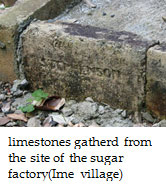 In 1801 the Satsuma Domain (now Kagoshima Prefecture) began experimental white sugar production in Amami under the guidance of a technician from Sanuki in Shikoku. Until this time, only unrefined or "black" sugar had been manufactured in Amami. Two years later the Satsuma Domain demanded a tribute of 12 tons of sugar from Amami, Tokunoshima, and Kikaijima. Howeverthe strain placed on farmers was severe, and production was later discontinued.
In 1865 Hisamitsu Simazu rose to power in Satsuma, and he invited two engineers from England, bought foreign-made machinery, and recommenced the production of white sugar. It was an innovative attempt to reverse the slide in government revenue that falling prices for unrefined sugar was causing. Four factories were built: one in Setouchi (Kuji) using machinery made in the Netherlands, the other three in Amami-city (Kaneku), Uken (Suko), and Sedome (Tatsugo) using British machinery. Seven feudal retainers of the Satsuma Domain, one English interpreter, a doctor and about 120 laborers were brought to Amami for building the factories, a task which took three years. Production began soon after that. Unfortunately a scarcity of fuel and damage from typhoons quickly spelled the end of the Kuji factory―the plant was shut down after no more than two or three years in operation.
The Kuji sugar factory ruins now lie under orange groves and brush.
Tomi of Sekko
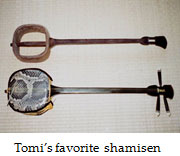 The flamboyant Tomi was born in Sekko in the early 1860s. Tall and elegant,
it was said that her beauty on horseback was incomparable. She charmed
men with her glossy black hair, beautiful voice and skill on the Shamisen.
The spirited Tomi followed a daring, freewheeling lifestyle, and her name
became known as far away as Naze.Tomi married a man from Agina, but she
soon divorced him and returned to her liberated Sekko lifestyle. She eventually
remarried, this time to a Kachiura man who was an outstanding hunter. She
loved to join him in the hunt, and they brought back boar from the mountains,
inviting their neighbours around for the feast.The grave of "Tomi
of Sekko", as her friends called her, can be found in Kachiura. She
passed away on February 19, 1933, aged 69.
Toramatsu Asa and the katsuo fishery of Nishikomi
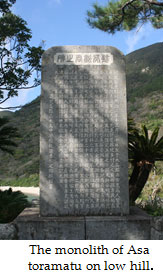 Toramatsu Asa of Nishikomi, a village near the western entrance of the Oshima Straits, pioneered the katsuo (skipjack tuna) fishing industry in Amami. Born in 1869, the young Asa had his first experience katsuo fishing on a boat that had sailed from Kagoshima. Seeing the large quantities of fish that could be landed in a relatively short period of time was a revelation to him. He convinced the people of Nishikomi that the industry was worth trying, and at the age of 32 formed the first katsuo fishermen's union in Amami.
Having diligently studied the technology behind the industry, Asa was able to create a fishery that was immediately successful, its activities quickly extending throughout the Setouchi and Uken areas. Within just three years, the union had some 130 fishing boats in operation. For more than a decade after that the industry continued to expand. Facilities for steaming and drying the fish to make katsuobushi lined the streets of Nishikomi, and even a ship repair yard and ice storage house were built there. Nishikomi became a bustling town of 370 households. Workers and merchants were attracted not only from Kagoshima and Okinawa, but from as far afield as Kobe and Osaka. Sadly, increased competition and persistent difficulties with financing led to the eventual scaling down of the Nishikomi fishery.
In 1914 a monument to the achievements and character of Toramatsu Asa was built on a hill in Nishikomi by the members of the Oshima Fisheries Union. Asa passed away in 1922.
The Hōan-den
The Hōan-den was a special building, separated from the main school buildings,
in which the portraits of the Japanese Emperor and Empress, together with
the so-called "Imperial Rescript on Education" document, were
housed. At all important school events and ceremonies teachers and pupils
alike would have to bow deeply towards the portraits, and the Rescript
would be given a reverential reading. Not only this, but teachers and students
were required to bow towards the Hōan-den whenever arriving at or leaving
the school, and would have to straighten their clothes and and bow every
time they passed in front of this building.After World War II, this practice
was forbidden by the Occupation authorities, and most Hōan-den was destroyed.
In Setouchi however, six Hōan-den buildings escaped this fate, and continued
to be used for storage or other purposes. In April 3 of 2006, these Hōan-den
were given protection as "Registered Tangible Cultural Assets",
and as such now cannot be pulled down or significantly altered in appearance.
The six remaining Hōan-den can be found in the grounds of the Koniya elementary
school, Sekko elementary-junior high school, Ikeji elementary-junior high
school, Satsukawa elementary school, Sukomo elementary school, and Kiji
elementary school (this school has been closed down).
Battlefields
Setouchi during the War
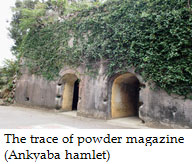 The Oshima Strait, sandwiched between ria (drowned river valley) coasts, had been regarded by the Japanese army as a strategic location since the late 1800s. In 1941, at the beginning of the Pacific War phase of the Second World War, navy land forces were sent to Sesou. The following year a defence corps was added, and Sesou also served as a base for the navy's Ryukyu operations. A naval construction party was placed in Miura, and a naval air corp base was placed in Sude to protect shipping in the Ryukyu area. During the Battle of Okinawa, twenty forays against American shipping were made from Setouchi.
The Amami Oshima military headquarters (built in 1920) was located where Koniya Prefectural High School now stands, the Amami Oshima army hospital once stood where Koniya Junior High School now is, and the Koniya military police occupied the site of the old Koniya Post Office.
From 1944 until the end of the war, shinyō (suicide boat) bases were located
in Miura, Nominoura and Kuji. Like the more famous kamikaze, the shinyō
(speedboats packed with explosives) were part of the Japanese Special Attack
Units program.
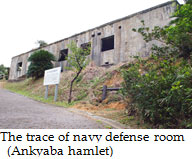 Aerial strafing by machine gun was largely responsible for the deaths of 32 people in Setouchi, and a total of 2209 houses burned down. Villages near antiaircraft positions suffered greatly, with Yoro, Ikedi, Akitoku, Tokuhama, Sachiyuki, Nishiamuro, Sesou, Shiba, Saneku, Sekko, Kunetsu, and Koniya being virtually burnt to the ground.
In almost every village in Setouchi, and in the mountains and coastlines that surround each one, the Japanese army had a presence: air-raid shelters, interceptor bases, ammunition stores, aircraft hangars, barracks, and gun positions were all to be found.
In Tean, Ankyaba and Nishikomi are well-managed war memorial sites where remnants of the war can still be seen.
|

